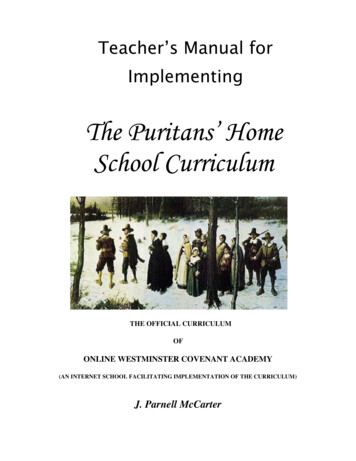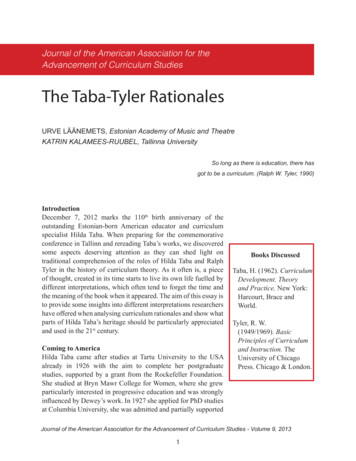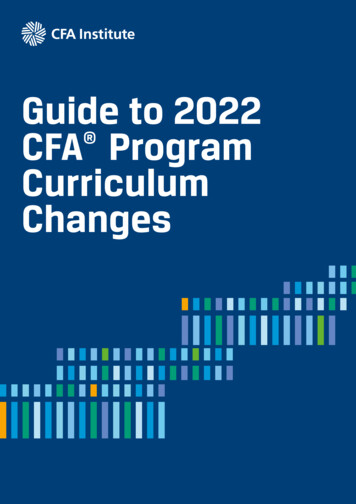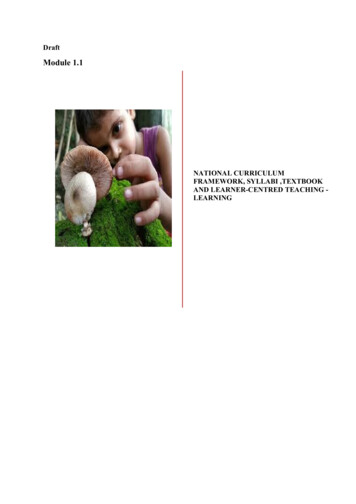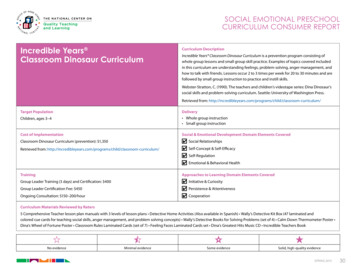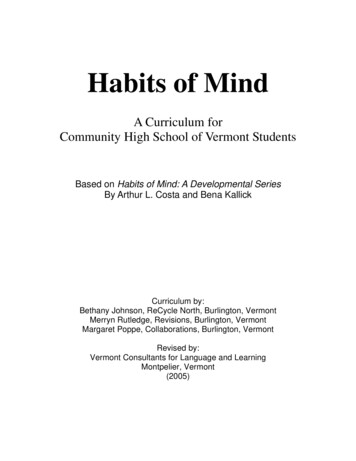
Transcription
Habits of MindA Curriculum forCommunity High School of Vermont StudentsBased on Habits of Mind: A Developmental SeriesBy Arthur L. Costa and Bena KallickCurriculum by:Bethany Johnson, ReCycle North, Burlington, VermontMerryn Rutledge, Revisions, Burlington, VermontMargaret Poppe, Collaborations, Burlington, VermontRevised by:Vermont Consultants for Language and LearningMontpelier, Vermont(2005)
Table of ContentsHabits of MindForeword. 3Introduction . 4Curriculum Overview. 5Instructional Approach . 7VT Standard-to-Lesson Reference Table . 8Lesson 1: Introduction to the Habits of Mind and Habits Portfolio . 9Lesson 2: Thinking about Thinking (Habit 1) . 12Lesson 3: Remaining Open to Continuous Learning (Habit 2) . 16Lesson 4: Thinking Flexibly (Habit 3) . 21Lesson 5: Persisting (Habit 4). 27Lesson 6: Finding Humor (Habit 5) . 31Lesson 7: Striving for Accuracy (Habit 6). 34Lesson 8: Listening with Understanding and Empathy (Habit 7) . 38Lesson 9: Gathering Data through All the Senses (Habit 8) . 44Lesson 10: Thinking and Communicating with Clarity and Precision (Habit 9). 48Lesson 11: Thinking Interdependently (Habit 10) . 56Lesson 12: Creating, Imagining, and Innovating (Habit 11) . 65Lesson 13: Responding with Wonderment and Awe (Habit 12). 72Lesson 14: Applying Past Knowledge to New Situations (Habit 13) . 75Lesson 15: Questioning and Posing Problems (Habit 14) . 77Lesson 16: Managing Impulsivity (Habit 15) . 80Lesson 17: Taking Responsible Risks (Habit 16) . 84Lesson 18: Putting it All Together . 87Lesson 19: Course Project. 95Appendix A: Lessons and Worksheets to be Included as a Student Manual. 97Appendix B: Lessons Rubric. 98Appendix C: Pre- and Post–Self-Assessment of Habits of Mind. 101Appendix D: Habits of Mind . InsertReferences. 105Habits of Mind2
Habits of Mind for Community High School of VermontForewordThis curriculum was authored in 2004 by Bethany Johnson, ReCycle North,Burlington, Vermont, Merryn Rutledge, Revisions, Burlington, Vermont, andMargaret Poppe, Collaborations, Burlington, Vermont. The curriculum wasinitially offered only at facilities where the Workforce Development Programwas operating. After being used successfully in those facilities for a full year,the curriculum was revised in 2005 by Vermont Consultants for Languageand Learning, so that the curriculum could be offered at any Community HighSchool of Vermont site as a vocational education class.Habits of Mind3
Habits of Mind for Community High School of VermontIntroductionA classroom environment provides many opportunities to influence behavior,cognitive behavior, learning, and growth. The focused, intentional waystudents interact in class with high school faculty and other students can beextended to interactions outside class with work supervisors and correctionalstaff. The residential, school, and work environments together will supportand enhance social and life skills development of offenders.This course aims to: Support successful community reintegration Improve employability Improve job retention Enhance by offender choice a reconnection to society Build a sense of empowerment through the application of new skills Improve collaboration both in the facility and out in the communityHabits of MindThe 16 Habits of Mind are habits of thought and action that help peoplemanage uncertain or challenging situations. They can help people take actionwhen there is no known solution to a problem. The Habits support thoughtfuland intelligent action.The 16 Habits of Mind are: Thinking about Thinking Remaining Open to Continuous Learning Thinking Flexibly Persisting Finding Humor Striving for Accuracy Listening with Understanding and Empathy Gathering Data through All the Senses Thinking and Communicating with Clarity and Precision Thinking Interdependently Creating, Imagining, and Innovating Responding with Wonderment and Awe Applying Past Knowledge to New Situations Questioning and Posing Problems Managing Impulsivity Taking Responsible RisksHabits of Mind4
Habits of Mind for Community High School of VermontCurriculum OverviewPurposes and goals of the courseThe purposes of this class are to: Explore definitions for each of the 16 Habits of Mind. Provide practice in using and thinking about the Habits of Mind. Support offenders in making behavior changes that reflect the Habitsof Mind.Lesson numbers, length of lessons, and suggested scheduleThe curriculum is divided into nineteen modules. Modules are designedeither as one-hour sessions or as two one-hour sessions and should beadaptable to the different schedules of individual facilities. The format of thecourse will vary by facility, as some may meet twice a week, others onlyonce. Experienced instructors will realize that some activities can beshortened or lengthened, depending upon presentation style, learnerinterest, and the time available. Lessons can be rearranged to suit the needsof the Department of Corrections that is using the curriculum.This course ends with a final project. While introducing the project early ongives students time to think about the form their project will take, instructorsshould not be bound to start it at any particular point. Students should countproject work as outside of class time. Lesson 13 includes built-in time forworking on the final project, and the last lesson describes the project andsuggests project ideas (for example, a skit or series of skits, a cartoon book,a board or card game, a collage, or a quilt). There are many options.Instructors should dedicate at least one class at the end of the course tocompleting and sharing project work.The course is designed to be not less than 20 hours long but could be as longas 30 hours, based on each facility’s schedule and instructor choices.The lessons are presented in the recommended order:1. Introduction to the Habits of Mind and Habits Portfolio2. Thinking about Thinking3. Remaining Open to Continuous Learning4. Thinking Flexibly5. Persisting6. Finding Humor7. Striving for Accuracy8. Listening with Understanding and Empathy9. Gathering Data through All the Senses10.Thinking and Communicating with Clarity and Precision11.Thinking Interdependently12.Creating, Imagining, and Innovating13.Responding with Wonderment and AweHabits of Mind5
14.Applying Past Knowledge to New Situations15.Questioning and Posing Problems16.Managing Impulsivity17.Taking Responsible Risks18.Putting It All Together19.Course ProjectModule ComponentsEach lesson contains all the information, directions, and worksheets thatinstructors need, unless otherwise indicated.Lessons are organized with the following headers: Lesson Objectives Lesson Overview Materials Methodology Activity Guided Group Discussion Reflection Optional Ways to Teach WorksheetsNotes to Instructor are inserted throughout the manual to clarify or highlightpoints.Habits PortfolioStudents are introduced to the Habits Portfolio in Lesson 1 and build it overthe succeeding lessons. The beginning Habits Portfolio is included asAppendix D. All students should keep their Habits Portfolio with additionalpages in a plastic binder, folder, or notebook. Journal activities are/may bepart of the portfolio.Habits of Mind6
Habits of Mind for Community High School of VermontInstructional ApproachThis class design emphasizes experiential learning and reflection.Accordingly, presentation of concepts is kept to a minimum and is embeddedin Guided Group Discussion. Participants are encouraged to learn throughpractice first and then followed by discussion.Similarly, most lessons end with one or more kinds of structured reflection.Students should keep reflection worksheets in their Habits Portfolio.Instructors may also choose to have students share their reflections in alarge group. Reflection activity helps offenders personalize and internalizetheir learning and apply this learning to life outside the classroom.Not all students learn the same way, and in any classroom there will bestudents who are comfortable writing and students who are not. For thisreason, many lessons include optional teaching activities to accommodate avariety of learning styles, ages, genders, abilities, and reading grade levels.Instructors should adapt their teaching methods and activities to meet theirstudents’ needs.Department of Corrections residents are called “offenders” or “students,”because they all are enrolled in the Community High School of Vermont.Instructors should use another name, such as “inmates,” according to thecustom of their corrections system.Appendix AThis is a list of handouts that should be included in a student handbook.Appendix BLessons RubricAppendix CPre– and Post–Self-AssessmentAppendix D16 Habits of Mind Portfolio (PowerPoint)Habits of Mind7
Vermont Standard-to-Lesson Reference ChartVERMONTSTANDARDLESSON 1LESSON 2LESSON 3LESSON 4LESSON 5LESSON 6LESSON 7LESSON 8LESSON 9LESSON 10LESSON 11LESSON 12LESSON 13LESSON 14LESSON 15LESSON 16LESSON 17LESSON 18LESSON 19(Standards addressed – Standards actually achieved are determined by the XXXXXXXXXXXXXXHabits of MindXXXXXXXXXXXXXXXXXXXXXXXX8
Teaching Habits of MindLesson 1: Introduction to the Habits of Mind andHabits Portfolio1 hourLesson Objectives: Students will describe Habits in their own words. Students will understand how to build a Habits Portfolio.Lesson Overview:Provide an overview of the course and how to build a portfolio. Students willuse a word splash to describe each Habit in their own words. This activitygives students a chance to think about each Habit and define it in personalterms.Materials: Newsprint and markers or individual papers and markers for small group Paper and fine-tip markers A portfolio journal with additional pages in a binder, folder, or notebookMethodology:Word Splash and Walkabout Poster sessionStudent journalInstructor NoteThis lesson is taught through the use of a word splash during a walkaboutposter session.Word splash: a collection of key terms, synonyms, and phrases thatconvey meaning similar to a particular term. . . . It enhances fluency withthe terms and elaborates their meaning. A word splash also enhancesflexibility by providing a group of terms rather than restricting someone tothe use of a single term.Walkabout poster session: an opportunity for people to get up and move.Moving is important for people who may have difficulty sitting still for longperiods for a variety of reasons. This activity also enables people toparticipate actively in a variety of ways. Students who are less verbal orarticulate can draw symbols or participate actively by reading what otherswrite. Walking about also helps people mix with people they don’t know.Activity (20 minutes)Place posters labeled with each Habit on the walls around the room. Giveeach participant a marker.Ask students to walk about and stop at each poster. Think of a word or shortphrase that describes each Habit for them and add it to the list.Habits of Mind9
Instructor NoteStudents are not required to have a word for each Habit, but areencouraged to add one. They are at least expected to stop by eachposter and think about what the Habit means to them and look at whatother people have written. Alternative ActivityThis activity can also be done as an individual activity. Give students 16sheets with one Habit title on each and ask them to write all the words theycan think of under each Habit.Guided Group Discussion (15 minutes)After everyone has completed a walkabout, regroup and read the lists. Askfor any additional words the group would like to add.Portfolio Activity (15 minutes)Refer students to the 16 Habits of Mind Portfolio and introduce them to thisongoing activity.Instructor NoteThe Portfolio is in a PowerPoint presentation. Students will have a pagefor each Habit. You may want to add additional pages between eachHabit. For students who use art to record their experiences, you maywant to add additional plain sheets.Today, we will begin to use a portfolio that will help you keep track ofhow you use the 16 Habits. After each lesson, you will have a chance topractice Thinking about Thinking by referring to that Habit andintentionally practicing it between classes. Each portfolio page will havemultiple entries, because you will often use several Habits together. Asyou try each new Habit, think about the others you are using. Makeentries under every Habit as you use it.As you try out each Habit and reflect on it, you are being Open toContinuous Learning. Ask yourself questions like:What happened when I used the Habit?So what? What does it mean?What now? How will this learning help me on the living unit, in my jobassignment, at school, and in the future?Tell students that you may also give them some other questions to thinkabout after each lesson.Refer students to the Walkabout Posters. Give them the opportunity tocopy into their portfolios the Habit descriptions they made.Habits of Mind10
Guided Group Discussion (10 minutes)Address confidentiality issues according to the policies in your facility.Students should be asked to respect each other’s privacy. If living-unitstaff has access to the journals, they should use the journals to supportlearning. All these issues should be addressed openly with staff andstudents.Optional Ways to TeachFor students who find writing challenging, you can use alternativeapproaches. They can record journal entries on a tape recorder you have inthe classroom. They can use art or story boards to express what theylearn. You can schedule periodic interviews with students. Students couldwrite raps or songs.The objective will be met if students reflect on each Habit, try it out, andreflect on how they use it. The portfolio should be progressive and studentsshould continue to reflect on all Habits as they begin to use them incombination with each other.Optional Activity: Self-AssessmentAdminister the Learner’s Pre–Self-Assessment of their Habits of Mind.Habits of Mind11
Habit 1: ThinkingTeaching Habits of MindLesson 2: Thinking about Thinking (Habit 1)1 hourLesson Objectives: Describe habits and the reason for developing “Habits of Mind.” Use Thinking about Thinking as a way of reflecting on the use of theHabits of Mind.Lesson Overview:Introduce the concept of Thinking about Thinking.Materials: Newsprint and easel Markers Paper and pencilMethodology:Guided Group DiscussionActivity: brainstormingReflectionActivity (30 minutes)Over the next 18 classes, we will explore new ways of thinking using the 16Habits of Mind. We will do this in class, and you will also try using thesethinking behaviors on the living unit and in your work activities.The 16 Habits of Mind are thinking behaviors that can be used effectively onmany occasions. The Habits of Mind help people manage uncertain orchallenging situations and take action when there isn’t a known solution to aproblem.Think for a few minutes about habits that you already have.Have students do individual or group brainstorming about habits they have(good, bad, and neutral). (Use newsprint pad for groups or individual sheetsfor one-on-one work.)What makes these habits?Refer to newsprint or student reports back to the group about the habits theyidentified.What do you see in common when you look at this list of habits?Habit 1: ThinkingHabits of Mind12
Summarize by pointing out that habits are things you do automatically.Instructor NoteYou might also get comments about habits that are annoying to otherpeople. That can be your cue to begin to present the 16 Habits as habitsthat we need to acquire and use appropriately. You might ask whenhabits serve us well and when they may even hurt us or hold us back.Guided Group Discussion (15 minutes)During this course, we will have a chance to look at all 16 Habits of Mind andpractice using them. Today let’s start by looking at Thinking about Thinking.By exploring our thinking and reflecting on our actions, we can decide howdifferent approaches to problems produce different results. Self-reflection orThinking about Thinking is a Habit that most people need to develop. It isn’tautomatically something people do like [refer back to their brainstorm list forexamples], but it can become a habit and it’s a good one to have (unlikechewing your nails or cracking your knuckles).What is a habit you have or have had that helped you, for example, do a jobwell or be in a relationship? What would it be like if we had good thinkinghabits that helped us grow?Give examples of what you think about when you are planning to dosomething or make a decision. Write these on a flip chart or white board.What would it be like if we had thinking habits that automatically helped usthink about the impact of our choices before we acted?Add to the list the group developed . . . Some other Thinking about Thinkingskills include:Instructor NoteUse language that your students will understand to explain these skills.Add the ones that the group did not come up with. They may haveused different words to mean the same thing, and you can elaborate ontheir words to acknowledge their contributions.Asking yourself questionsDeveloping mental mapsMentally rehearsingChecking and adjusting actions as neededReflecting and evaluatingReflecting on our actions gives us an opportunity to think about why wedo what we do. During this course, you will have a chance to practiceThinking about Thinking skills deliberately.Habits of Mind13
Reflection (15 minutes) Lesson 2 Worksheet 1: Reflective JournalHave students write about the thinking they used in making a decision orsolving a problem. Refer them to their worksheet.Close by asking for any Thinking about Thinking skills they used inmaking this decision or solving a problem. Tell them they will bepracticing this skill every time they reflect on the use of a Habit.Optional Ways to TeachYou can also have students tell their story to a partner.Habits of Mind14
Lesson 2 Worksheet 1Reflective Journal1. Describe an interaction, a situation, or problem that needed a solution.2. Describe your thinking. How did you decide what to do?3. Did you use any of these Thinking about Thinking strategies?Asking yourself questionsMentally rehearsing or practicingExploring a variety of optionsUsing past experience to inform your choicesMonitoring and changing your actions as needed4. What was the outcome and how did you feel about it?5. If you had it to do over again, would you think it out differently?Habits of Mind15
Habit 2: Remaining OpenTeaching Habits of MindLesson 3: Remaining Open to Continuous Learning (Habit 2)1 hourLesson Objectives: Reflect on past and future learning. Identify at least one learning goal.Lesson Overview:This lesson encourages students to remain open to continuous learning. Thelesson begins by asking students to reflect on ways that they learn.Students go on to identify ideas and activities that they have foundrewarding and challenging. Students are then asked to think about newthings that they would like to learn about and the steps they’ll take to getthere. Goal setting is practiced. Goals should be specific (I’d like to learnmore about other religions) rather than general (I’d like to be a nicerperson). The reflective journaling asks students to reflect on the reasonsthey volunteered for this class and how they will remain open to continuouslearning after this class.Materials: Lesson 3 Worksheet 1: Learning Styles Lesson 3 Worksheet 2: Goal Setting Lesson 3 Worksheet 3: Reflective Journal Chalkboard or newsprint Chalk or markers Paper, pencilsMethodology:Guided Group DiscussionActivityReflectionActivity (20 minutes)Ask the group to think about ways they have learned. What people havethey learned from? Where have they learned? How have they learned?Have students write their answers on the board. The list might includeschools, friends, family, jobs, doing things, books, and movies. Use theresponses to introduce discussion of learning styles.Hand out Lesson 3 Worksheet 1: Learning Styles. When students havefinished answering questions, ask for a show of hands to see whatpercentage of the class falls into each of the three categories.Habits of Mind16
Habit 2: Remaining OpenGuided Group Discussion (15 minutes)Ask students to think about things they’ve done that were rewarding andchallenging and have students share some of their answers. Then ask themwhat new things they would like to learn to do. Spend some time on thisquestion so that each student has had a chance to think about his/heranswer and share it with the group.Activity (15 minutes)Lesson 3 Worksheet 2: Goal SettingSetting learning goals is one way to achieve a more fulfilling life. To set agoal, you need to know what it is you want to accomplish, how you canmeasure what you’ve accomplished, and how long it will take to reach yourgoal. Ask students to fill out the goal setting worksheet for something newthat they would like to learn.Instructor NoteAt the end of ten minutes, ask one or more volunteers to share whatthey’ve written. At each step, encourage students to be very specific.Ask the class to help their classmates be specific.Reflection (10 minutes)Lesson 3 Worksheet 3: Reflective Journal QuestionsAsk for volunteers to share their answers.Instructor NoteMake time in a future class to revisit this worksheet and check in withstudents on their progress. Encourage students to persist and continuegenerating new topics to explore.Optional Ways to TeachIf students are uncomfortable with writing, you can write these questions onthe board or paper and ask students to answer the questions out loud.
Lesson 3 Worksheet 1Learning StylesLearning StylesThis chart helps you determine your learning style. Read the word in the farleft column and then answer the questions in the next three columns to seehow you respond to each situation. Your answers may fall into all threecolumns, but one column will likely contain the most answers. The dominantcolumn indicates your primary learning style.When you SpellTalkVisualDo you try to see theword?Do you talk sparingly, butdislike listening for toolong? Do you favor wordssuch as see, picture, andimagine?Meet someoneagainDo you become distractedby untidiness ormovement?Do you forget names butremember faces orremember where you met?Contact peopleon businessDo you prefer direct, faceto-face, personalmeetings?ConcentrateReadDo somethingnew at workPut togethersomethingNeed helpwith acomputerapplicationDo you like descriptivescenes or pause to imaginethe actions?Do you like to seedemonstrations, diagrams,slides, or posters?Do you look at thedirections and the picture?Do you seek out picturesor diagrams?AuditoryDo you sound out theword or use aphonetic approach?Do you enjoylistening, but areimpatient to talk? Doyou use words suchas hear, tune, andthink?Do you becomedistracted by soundsor noises?Do you forget facesbut remember namesor remember whatyou talked about?Do you prefer thetelephone?Do you enjoydialogue andconversations or hearthe characters talk?Do you prefer verbalinstructions or talkingabout it withsomeone else?Do you read thedirections out loud orhave someone readthem to you?Do you call the helpdesk, ask a neighbor,or growl at thecomputer?Kinesthetic andTactileDo you write theword down to find if itfeels right?Do you gesture anduse expressivemovements? Do youuse words such asfeel, touch, and hold?Do you becomedistracted by activityaround you?Do you rememberbest what you didtogether?Do you talk withthem while walking orparticipating in anactivity?Do you prefer actionstories or are not akeen reader?Do you prefer tojump right in and tryit?Do you ignore thedirections and figureit out as you goalong?Do you keep trying todo it or try it onanother computer?TOTALHabits of Mind18
Lesson 3 Worksheet 2Goal Setting1. What learning goal do I want to accomplish?2. What steps do I need to take to reach my goal?3. How will I evaluate/measure my progress?4. How much time will it take to reach this goal?Habits of Mind19
Lesson 3 Worksheet 3Reflective Journal1. I decided to be part of this class because . . .2. As a result of this course, I hope to be more open to . . .3. What will frustrate me most about reaching the goal from the worksheetwill be . . .4. What will make me feel best about reaching my goal will be . . .5. What other skills and knowledge do I want to learn in my life?Habits of Mind20
Habit 3: Thinking FlexiblyTeaching Habits of MindLesson 4: Thinking Flexibly (Habit 3)Two 1-hour SessionsLesson Objectives: Identify examples of Thinking Flexibly. Complete one problem-solving analysis using S.O.D.A.S. process.Lesson Overview:In the first session, students are introduced to the Habit and watch asegment of Apollo 13. Students identify how the NASA team used ThinkingFlexibly. The reflection activity offers students the opportunity to observeinstances of Thinking Flexibly during the week.In the second session, students engage in a fun activity that challenges themto Think Flexibly. They then use Thinking Flexibly to assess a problem andarrive at a solution.Materials: TV/VCR or DVD Apollo 13 videotape or DVD cued to segment where the CO2 begins toclimb and ending with the end of the simulator sequence right after theconstruction of the makeshift CO2 filter. Word splash posters A/V equipment, visuals Lesson 4 Worksheet 1: Second Session Activity Lesson 4 Worksheet 2: S.O.D.A.S. WorksheetMethodology:Watch Apollo 13 segmentGuided Group DiscussionActivityGuided Group Discussion (10 minutes)Ask the group to describe Thinking Flexibly and give examples.Do you know anyone who is a flexible thinker?What does a flexible thinker act like?How does this person meet challenges?Habits of Mind21
Habit 3: Thinking FlexiblyInstructor Note:You can refer them back to the word splash posters and Habits Portfolio as areference for their beginning thoughts on this Habit.Thinking Flexibly requires:Altering our perspective and seeing things from another’s point of viewSeeing the big pictureSeeing the detailsStarting at the end point and working backwardFlexible thinkers:Change their minds as they get new informationUse different ways to solve problemsMove between looking at the big picture and paying attention to detailsUse new approaches from different angles (lateral thinking)Think from alternate points of view at the same timeWork within rules and guidelines and predict the results of floutingthemTake a bird’s-eye view and find themes and patternsActivity (30 minutes)Watch segment of Apollo 13 from the discovery of the air-filter problem tothe production of the filter. Ask students to watch for flexible thinkingbehavior. Ask them to name examples of Thinking Flexibly.Post the word splash or give each student a copy of the Thinking Flexiblyword splash. Give students dots or highlighters to identify each behavior onthe word splash poster they observed in the film clip.Guided Group Discussion (10 minutes)Summarize key points by elaborating on the students’ observations ofThinking Flexibly. Summarize the dots on the word splash poster and reviewthe slide for the key points. Ask if they want to add any words to the wordsplash. Add these words or phrases to the big poster and have them addthem to their own lists.Reflection (10 minutes)Ask students to refer to their 16 Habits of Mind portfolios.In what situations are you most likely to try out Thinking Flexibly?Which behaviors on the word splash did you try?What happened?How will this learning help you in the living unit, in your job placement, at school, andin the future?
Try using Thinking Flexibly this week and write about it in your portfolio. If you noticesomeone who demonstrates Thinking Flexibly, jot down your observation in yourportfolio.2nd Session Activity (10 minutes)Project visuals such as Old Lady/Young Woman (Worksheet 1) to engagestudents in a fu
Habits of Mind for Community High School of Vermont Curriculum Overview Purposes and goals of the course The purposes of this class are to: Explore definitions for each of the 16 Habits of Mind. Provide practice in using and thinking about the Habits of Mind. Support offenders in making behavior changes that reflect the Habits of Mind.







